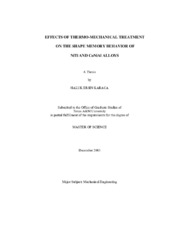| dc.description.abstract | Nickel-Titanium (NiTi) shape memory alloys have been the focus of extensive research due to its unique characteristics such as high recoverable strain and ductility. However, solutionized samples of NiTi do not demonstrate good shape memory characteristics due to low strength for dislocation slip. Thermo-mechanical treatments are required to strengthen the matrix and improve the shape memory characteristics. Plastic deformation and the subsequent annealing is the common way to improve shape memory properties. In this case, deformation magnitude, temperature, rate, mechanism, and annealing temperature and time are all important parameters for the final shape memory properties. Equal channel angular extrusion (ECAE) is a well-known technique to severely deform materials by simple shear with no change in cross-section. In this study, Ti- 49.8 at% Ni samples are deformed by ECAE at three different temperatures near transformation temperatures. X-ray analysis, calorimetry, transmission electron microscopy and thermo-mechanical cycling techniques are utilized to investigate the effects of severe deformation and subsequent annealing treatment on shape memory properties. Martensite stabilization, formation of strain induced B2 phase, change in transformation temperatures, formation of new phases, recrystallization temperature, texture formation, and increase in strength and pseudoelastic strain are the main findings of this study.
Co-32.9 at% Ni-29.5 at% Al is a newly found ferromagnetic alloy. Its low density, high melting temperature and cheap constituents make the alloy advantageous among other shape memory alloys. Although some magnetic properties of this alloy are known, there is no report on basic shape memory characteristics of CoNiAl. In this study, effect of thermo-mechanical treatments on the microstructure and shape memory characteristics such as transformation behavior, pseudoelasticity, stages of transformation, temperature dependence of the pseudoelasticity, response to thermal and stress cycling is investigated. Formation of second phase along the grain boundaries and inside the grains, about 4% pseudoelastic and two-way shape memory strain, very narrow stress hysteresis, large pseudoelastic window (>150°C), two-stage martensitic transformation, stable response to cyclic deformation, high strength for dislocation slip, slope of Clasius-Clapeyron curve, and twinning plane are determined for the first time in literature. | en |


